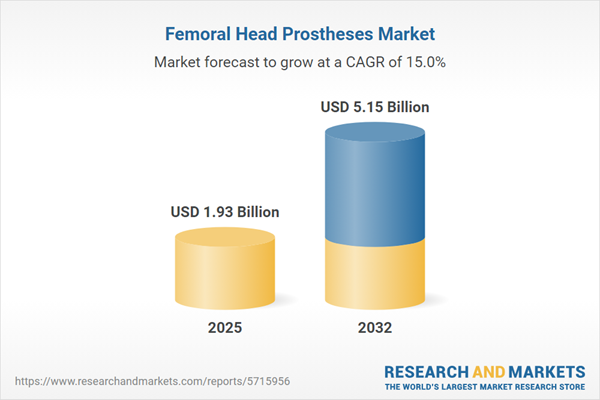Speak directly to the analyst to clarify any post sales queries you may have.
The femoral head prostheses market is transforming in response to ongoing innovation and evolving healthcare standards, requiring informed, strategic decision-making. Senior executives must assess this changing environment to position their organizations for continued growth and operational advantage.
Market Snapshot: Femoral Head Prostheses Market Size and Growth
In 2024, the femoral head prostheses market size reached USD 1.68 billion, poised to expand to USD 1.93 billion in 2025 at a CAGR of 14.96%. This robust growth is driven by escalating demand for hip replacement surgeries, increasing adoption of advanced implant technologies, and heightened focus on clinical outcome improvement. Enhanced research and development activity, progress in minimally invasive orthopedic procedures, and stricter regulatory frameworks are redefining industry practices. The value chain is increasingly oriented toward patient-centric care, with buying processes growing more sophisticated as healthcare providers demand tailored solutions.
Scope & Segmentation: Strategic Market View
- End User: Hospitals and ambulatory surgical centers shape market demand, each with specific procedural approaches for both elective and revision surgeries. Their requirements result in diverse product preferences, procedural workflows, and follow-up needs.
- Fixation Method: Cemented and cementless methods empower clinical teams to optimize device choice based on patient bone quality, surgeon experience, and available resources. This selection directly affects patient recovery and procedural success.
- Distribution Channel: Direct sales, intermediary distribution, and digital procurement platforms allow suppliers to address varying procurement strategies across healthcare systems. Each channel influences the efficiency and availability of products.
- Product Type: Bipolar and unipolar devices fulfill both standard and complex hip replacement requirements, meeting a wide spectrum of patient and clinician demands for routine and specialized cases.
- Material: Ceramic (including alumina and zirconia), composite materials such as carbon fiber and PEEK, metal alloys like cobalt chromium and titanium, and polyethylene options are carefully selected to achieve reliability, longevity, and biocompatibility across surgical applications.
- Region: The Americas and Europe are established leaders in procedural adoption and clinical system development, while Asia-Pacific experiences sharp increases in surgery rates as access grows. Latin America, the Middle East, and Africa present operational and logistical challenges, requiring region-specific adaptation.
- Key Companies: Market leaders including DePuy Synthes, Zimmer Biomet, Stryker, Smith & Nephew, Corin Group, MicroPort Scientific, Exactech, DJO, B. Braun Melsungen, and Globus Medical continue to drive innovation, expand adoption, and foster differentiation through product evolution.
Key Takeaways: Strategic Insights for Decision-Makers
- Modern manufacturing techniques, such as additive manufacturing and digital pre-surgical planning, are supporting implant customization and streamlining surgical workflows for both providers and patients.
- Material science advances and enhanced wear performance are supporting greater prosthesis durability, strengthening patient trust and positively influencing provider reputation in a competitive marketplace.
- Supply chain collaboration and modular design features enable faster product introductions, allowing companies to react to clinician and patient needs and adapt to evolving market differentiation requirements.
- Global regulatory developments and tariff shifts are prompting organizations to reevaluate sourcing, seek local suppliers, and consider alternative raw materials for regulatory compliance and cost containment.
- Variations in reimbursement and purchasing frameworks demand agile business strategies that address shifting payer priorities and emerging healthcare delivery models across regions, supporting sustained market relevance.
- Sustained investment in surgeon education, post-market surveillance, and robust customer support remains vital for product adoption and ongoing organizational performance.
Tariff Impact: Mitigating Cost and Supply Chain Challenges
The femoral head prostheses market is directly impacted by recent U.S. tariff changes, especially concerning essential metals used in device manufacturing. To overcome these rising costs, leading organizations are intensifying local sourcing efforts, optimizing production footprints in priority regions, and evaluating material substitutions. These measures help organizations manage expenses while upholding quality and regulatory standards.
Methodology & Data Sources
This research combines expert interviews with orthopedic surgeons, device engineers, and supply chain specialists in major markets. Extensive desk research, analysis of regulatory submissions, and review of clinical registry data underpin the credibility of findings for all femoral head prostheses market stakeholders.
Why This Report Matters
- Delivers actionable intelligence on emerging drivers, regulatory developments, and competitive trends in the orthopedic industry.
- Enables executive teams to strengthen product development, mitigate commercial risks, and enhance efficiencies in supply chain strategies.
- Uncovers operational opportunities and segment-specific strategies for improving organizational performance within the femoral head prostheses market.
Conclusion
Long-term competitiveness in the femoral head prostheses market depends on swift adaptation to technology, tailored regional strategies, and proactive supply chain management. Organizations adopting these priorities are positioned to improve clinical outcomes and sustain leadership across the sector.
Additional Product Information:
- Purchase of this report includes 1 year online access with quarterly updates.
- This report can be updated on request. Please contact our Customer Experience team using the Ask a Question widget on our website.
Table of Contents
3. Executive Summary
4. Market Overview
7. Cumulative Impact of Artificial Intelligence 2025
List of Figures
Samples

LOADING...
Companies Mentioned
The key companies profiled in this Femoral Head Prostheses market report include:- DePuy Synthes, Inc.
- Zimmer Biomet Holdings, Inc.
- Stryker Corporation
- Smith & Nephew plc
- Corin Group Ltd
- MicroPort Scientific Corporation
- Exactech, Inc.
- DJO, LLC
- B. Braun Melsungen AG
- Globus Medical, Inc.
Table Information
| Report Attribute | Details |
|---|---|
| No. of Pages | 190 |
| Published | October 2025 |
| Forecast Period | 2025 - 2032 |
| Estimated Market Value ( USD | $ 1.93 Billion |
| Forecasted Market Value ( USD | $ 5.15 Billion |
| Compound Annual Growth Rate | 14.9% |
| Regions Covered | Global |
| No. of Companies Mentioned | 11 |









